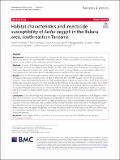| dc.description.abstract | Background: Aedes-borne diseases such as dengue and chikungunya constitute constant threats globally. In Tanzania, these diseases are transmitted by Aedes aegypti, which is widely distributed in urban areas, but whose ecology
remains poorly understood in small towns and rural settings.
Methods: A survey of Ae. aegypti aquatic habitats was conducted in and around Ifakara, a fast-growing town in
south-eastern Tanzania. The study area was divided into 200×200 m search grids, and habitats containing immature
Aedes were characterized. Field-collected Ae. aegypti were tested for susceptibility to common public health insecticides (deltamethrin, permethrin, bendiocarb and pirimiphos-methyl) in the dry and rainy seasons.
Results: Of 1515 and 1933 aquatic habitats examined in the dry and rainy seasons, 286 and 283 contained Aedes
immatures, respectively (container index, CI: 18.9–14.6%). In the 2315 and 2832 houses visited in the dry and rainy
seasons, 114 and 186 houses had at least one Aedes-positive habitat, respectively (house index, HI: 4.9–6.6%). The main
habitat types included: (i) used vehicle tires and discarded containers; (ii) fowerpots and clay pots; and (iii) holes made
by residents on trunks of coconut trees when harvesting the coconuts. Used tires had highest overall abundance of
Ae. aegypti immatures, while coconut tree-holes had highest densities per habitat. Aedes aegypti adults were susceptible to all tested insecticides in both seasons, except bendiocarb, against which resistance was observed in the rainy
season.
Conclusions: To our knowledge, this is the frst study on ecology and insecticide susceptibility of Ae. aegypti in Ifakara
area, and will provide a basis for future studies on its pathogen transmission activities and control. The high infestation levels observed indicate signifcant risk of Aedes-borne diseases, requiring immediate action to prevent potential
outbreaks in the area. While used tires, discarded containers and fowerpots are key habitats for Ae. aegypti, this study
also identifed coconut harvesting as an important risk factor, and the associated tree-holes as potential targets for
Aedes control. Since Ae. aegypti mosquitoes in the area are still susceptible to most insecticides, efective control could
be achieved by combining environmental management, preferably involving communities, habitat removal and
insecticide spraying | en_US |

